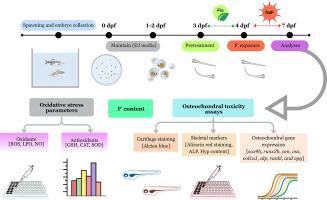Fisetin modulates fluoride induced osteochondral toxicity in zebrafish larvae
IF 4.3
3区 环境科学与生态学
Q2 BIOCHEMISTRY & MOLECULAR BIOLOGY
Comparative Biochemistry and Physiology C-toxicology & Pharmacology
Pub Date : 2025-09-06
DOI:10.1016/j.cbpc.2025.110351
引用次数: 0
Abstract
Excessive fluoride (F−) exposure, particularly during early development, poses a significant risk to skeletal integrity by disrupting bone homeostasis through oxidative stress and altered mineralization. While F− induced oxidative stress is well documented, studies investigating the role of natural antioxidants in mitigating F− induced osteochondral toxicity remain limited. Hence, the present study investigated the osteomodulatory effect of fisetin (Fis) against F− toxicity in zebrafish larvae. Fis (15 μM) was exposed to zebrafish larvae at 3 days post fertilization (dpf) for 24 h, followed by 72 h exposure to 25 ppm sodium fluoride (NaF). F− accumulation, oxidant (ROS, LPO, NO, PCC) and antioxidant (SOD, CAT, GSH) levels, cartilage (alcian blue staining), skeletal (alizarin red staining, hydroxyproline content, ALP activity) markers, and expression of osteochondral genes (sox9b, runx2b, ocn, osx, col1a1, alp, rankl, and opg) were assessed in control and treated larvae. F− exposure significantly elevated oxidative stress, disrupted craniofacial cartilage morphology, and induced premature ossification, alongside altered expression of osteogenic and resorptive markers. Remarkably, Fis pretreatment effectively reduced F− accumulation, restored redox homeostasis, preserved cartilage architecture, and normalized mineral deposition. Gene expression analysis further confirmed that Fis modulated key regulators of osteogenesis, chondrogenesis, and bone resorption, underscoring its osteoprotective role. Collectively, these findings demonstrate that Fis confers protection against F− induced osteochondral toxicity by attenuating oxidative stress, supporting bone matrix development, and regulating genes essential for bone homeostasis.

非西汀调节氟诱导的斑马鱼幼鱼骨软骨毒性。
过量的氟化物(F-)暴露,特别是在发育早期,通过氧化应激和矿化改变破坏骨骼稳态,对骨骼完整性构成重大风险。虽然F诱导的氧化应激有很好的文献记载,但关于天然抗氧化剂在减轻F诱导的骨软骨毒性中的作用的研究仍然有限。因此,本研究探讨了非西汀(Fis)对斑马鱼幼鱼F-毒性的骨调节作用。Fis(15 μM)在受精后3 天(dpf)暴露于斑马鱼幼虫24 h,然后暴露于25 ppm氟化钠(NaF) 72 h。测定F-积累、氧化剂(ROS、LPO、NO、PCC)和抗氧化剂(SOD、CAT、GSH)水平、软骨(alcian blue染色)、骨骼(茜素红染色、羟脯氨酸含量、ALP活性)标志物和骨软骨基因(sox9b、runx2b、ocn、osx、col1a1、ALP、rankl和opg)表达。氟暴露显著增加氧化应激,破坏颅面软骨形态,诱导过早骨化,同时改变成骨和吸收标志物的表达。值得注意的是,Fis预处理有效地减少了F-积累,恢复了氧化还原稳态,保存了软骨结构,并使矿物质沉积正常化。基因表达分析进一步证实Fis调节成骨、软骨形成和骨吸收的关键调控因子,强调其骨保护作用。总的来说,这些发现表明,Fis通过减轻氧化应激、支持骨基质发育和调节骨骼稳态所必需的基因,对F诱导的骨软骨毒性具有保护作用。
本文章由计算机程序翻译,如有差异,请以英文原文为准。
求助全文
约1分钟内获得全文
求助全文
来源期刊
CiteScore
7.50
自引率
5.10%
发文量
206
审稿时长
30 days
期刊介绍:
Part C: Toxicology and Pharmacology. This journal is concerned with chemical and drug action at different levels of organization, biotransformation of xenobiotics, mechanisms of toxicity, including reactive oxygen species and carcinogenesis, endocrine disruptors, natural products chemistry, and signal transduction with a molecular approach to these fields.

 求助内容:
求助内容: 应助结果提醒方式:
应助结果提醒方式:


